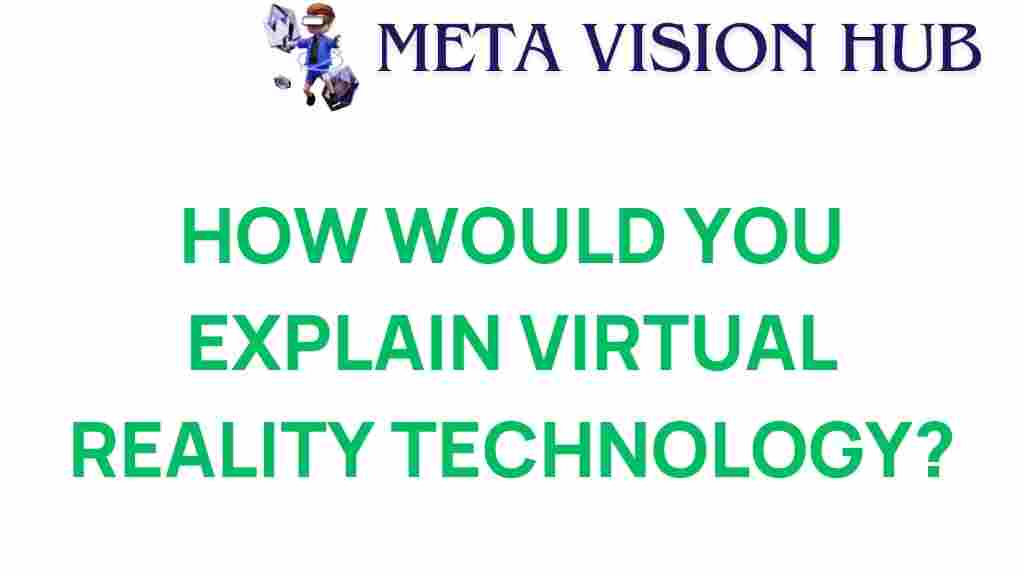Unlocking the Realms: A Deep Dive into Virtual Reality Technology
In recent years, virtual reality (VR) has transformed from a niche technology into a mainstream phenomenon, capturing the imagination of innovators, gamers, and everyday users alike. With the ability to create immersive experiences that transport users to entirely different worlds, VR is at the forefront of technological innovation. This article explores the multifaceted applications of VR, its impact on gaming, simulations, and the future trends shaping the user experience.
Understanding Virtual Reality Technology
Virtual reality is a computer-generated environment that allows users to interact with 3D worlds. Utilizing specialized hardware like VR headsets, gloves, and motion sensors, immersive experiences are created that engage the user’s senses, particularly sight and sound. This technology has applications that stretch far beyond gaming, encompassing education, training, healthcare, and more.
The Components of Virtual Reality
To fully understand how virtual reality works, it’s essential to break down its components:
- Hardware: Includes VR headsets (like Oculus Rift, HTC Vive), motion controllers, and tracking sensors.
- Software: VR applications and platforms that generate the virtual environments and experiences.
- Content: The actual experiences users engage with, ranging from games to educational simulations.
How Virtual Reality Works
The process of creating an immersive VR experience involves several key steps:
- Content Creation: Developers create 3D models and environments using software tools.
- Interaction Design: Designers implement controls that allow users to interact within the VR space.
- Testing: The VR experience is tested to ensure it is responsive and engaging.
- Deployment: The finished product is made available for users to download and experience.
VR Applications Across Different Sectors
Virtual reality is not limited to just gaming. Its applications span various industries, providing unique solutions and enhancing user experiences.
Gaming
The most well-known application of VR technology is in gaming. VR games offer players a unique level of interaction and immersion:
- Engagement: Players can physically move and interact with the game world, enhancing the sense of presence.
- Social Interaction: Multiplayer VR games allow users to engage with friends in a shared virtual space.
- Realism: Advanced graphics and sound design create lifelike environments that draw players in.
Education and Training
In education, immersive experiences through VR can enhance learning outcomes:
- Virtual Classrooms: Students can attend lectures in a virtual space, engaging with instructors and peers.
- Simulation Training: Professions such as medicine, aviation, and military use VR for realistic training simulations.
- Field Trips: Students can explore historical sites or natural wonders without leaving the classroom.
Healthcare
In the healthcare sector, virtual reality is revolutionizing patient care and medical training:
- Therapeutic Use: VR is used in exposure therapy for anxiety disorders and PTSD.
- Surgical Training: Surgeons can practice procedures in a risk-free virtual environment.
- Patient Education: Patients can gain a better understanding of procedures and conditions through immersive simulations.
Real Estate and Architecture
Real estate professionals and architects utilize VR to visualize properties and designs:
- Virtual Tours: Potential buyers can tour properties from anywhere in the world, saving time and resources.
- Design Visualization: Architects can present their designs in a fully immersive format, allowing for better client feedback.
Future Trends in Virtual Reality
The landscape of virtual reality is constantly evolving, with several trends emerging that promise to shape its future:
Advancements in Technology
As hardware and software continue to improve, the capabilities of VR technology will expand:
- Increased Accessibility: As prices decrease, VR headsets will become more accessible to the general public.
- Improved Graphics: Future VR systems are expected to deliver even more realistic graphics and smoother performance.
- Standalone Devices: More standalone VR devices that don’t require a powerful PC or console are being developed.
Integration with Other Technologies
Virtual reality is increasingly being integrated with other cutting-edge technologies:
- Artificial Intelligence: AI can enhance user interactions within VR environments, making experiences more responsive.
- Augmented Reality: Combined AR and VR experiences (collectively known as XR) are emerging for even richer interactions.
Enhanced User Experience
Creating a seamless and enjoyable user experience is a priority for VR developers:
- User-Centric Design: Focusing on intuitive controls and user-friendly interfaces will enhance accessibility.
- Social Experiences: Increasing emphasis on social interactions within VR will create community-driven experiences.
Troubleshooting Common VR Issues
While virtual reality offers amazing experiences, users may encounter some common issues. Here are troubleshooting tips for a smoother experience:
Performance Issues
If you experience lag or choppiness in your VR experience:
- Ensure your hardware meets the minimum requirements for the VR application.
- Close unnecessary background applications to free up system resources.
- Check for and install any software updates for your VR headset and applications.
Connectivity Problems
For issues related to connectivity:
- Ensure that all cables are securely connected and not damaged.
- Restart your VR headset and the device it’s connected to.
- Check your Wi-Fi connection if using a wireless VR system.
User Discomfort
If users feel discomfort or nausea while using VR:
- Take regular breaks to prevent fatigue and discomfort.
- Adjust the headset for a better fit, ensuring proper alignment with your eyes.
- Start with less intense experiences and gradually increase exposure.
Conclusion
As we explore the vast potential of virtual reality, it is clear that this technology is not just a passing trend but a revolutionary force across various sectors. From gaming to education to healthcare, VR is paving the way for immersive experiences that redefine how we interact with digital content. As innovations continue to emerge, the future of virtual reality promises to be even more exciting, with new applications and enhanced user experiences on the horizon.
To stay updated on the latest in VR technology and its applications, consider visiting resources like TechCrunch for news and insights. Additionally, if you want to explore further into how virtual reality can impact your industry, check our detailed guide on VR applications.
This article is in the category ImmersiveTech and created by MetaVisionHub Team
